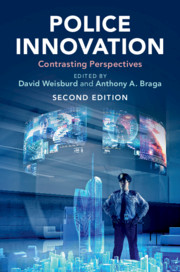Book contents
- Police Innovation
- Police Innovation
- Copyright page
- Contents
- Figures
- Tables
- Notes on Contributors
- Introduction
- Part I Community Policing
- 1 Advocate
- 2 Critic
- Part II Procedural Justice Policing
- Part III Broken Windows Policing
- Part IV Problem–Oriented Policing
- Part V Pulling Levers (Focused Deterrence) Policing
- Part VI Third–Party Policing
- Part VII Hot Spots Policing
- Part VIII Predictive Policing
- Part IX CompStat
- Part X Evidence-Based/ Risk-Focused Policing
- Part XI Technology Policing
- Index
- References
2 - Critic
Community Policing: A Skeptical View
from Part I - Community Policing
Published online by Cambridge University Press: 09 August 2019
- Police Innovation
- Police Innovation
- Copyright page
- Contents
- Figures
- Tables
- Notes on Contributors
- Introduction
- Part I Community Policing
- 1 Advocate
- 2 Critic
- Part II Procedural Justice Policing
- Part III Broken Windows Policing
- Part IV Problem–Oriented Policing
- Part V Pulling Levers (Focused Deterrence) Policing
- Part VI Third–Party Policing
- Part VII Hot Spots Policing
- Part VIII Predictive Policing
- Part IX CompStat
- Part X Evidence-Based/ Risk-Focused Policing
- Part XI Technology Policing
- Index
- References
Summary
About three decades ago, a few American police leaders caught the wave of community policing reform, and now just about everybody has gone surfing. If recent nationwide polls of police are indicative, many lower-ranking officers are catching the community policing wave (Mastrofski, 2017). Early interest in this reform can be attributed to police anxieties in the 1960s and 70s about skyrocketing crime and urban violence, unmet rising expectations from the civil rights movement, and middle-class alienation from government authority (Fogelson, 1977: ch. 11). Like a “perfect storm” these forces converged, stimulating criticism from blue ribbon commissions and a daily drumbeat of negative press for police. Calls for change were issued, some radical: community control of policing, deprofessionalization, and reassignment of some core police tasks to other government agencies and the private sector. Alarmed and intent on ending this crisis of legitimacy (LaFree, 1998), progressive police and scholars began to explore ways to make American police both more effective and more democratic without losing many of the advances made in policing in the previous half century (Goldstein, 1977; 1990; Trojanowicz & Bucqueroux, 1990; Wilson & Kelling, 1982). The resulting community policing reforms were influenced by fashions in organization development intended to make agencies less bureaucratic, more responsive to the “customer,” and more results oriented (Mastrofski, 1998; Mastrofski and Ritti, 2000). Although early twenty-first-century concerns about the threat of terrorism may have dissipated federal financial support for community policing, highly publicized events featuring violence between police and the community have stoked alarm about the state of police–community relations, resulting in a national blue-ribbon commission document that once again advances community policing as a key to American policing that is more effective and legitimate (President’s Task Force, 2015: 43): “Recommendation: Community policing should be infused throughout the culture and organizational structure of law enforcement agencies.”
- Type
- Chapter
- Information
- Police InnovationContrasting Perspectives, pp. 45 - 68Publisher: Cambridge University PressPrint publication year: 2019
References
- 3
- Cited by

